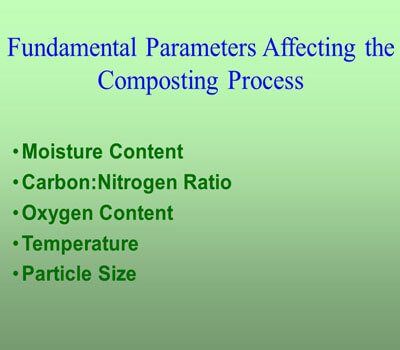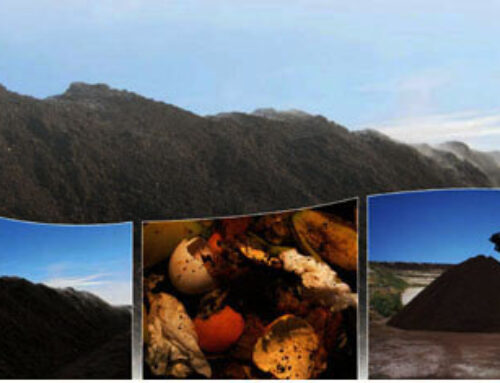
Refuse or Municipal Solid Waste composting, in brief, is the microbial reaction process using microorganisms to promote the biodegradable organics in the garbage to transform into stable humus. During this process, the organics in the refuse dump make interaction with oxygen and bacteria, releasing carbon dioxide, water, and heat, generating humus at the same time. one of the Benefits of MSW compost is that it can be used as a soil improvement agent. The waste composting method can not only increase soil humus and nutrient but also save a large number of soil resources without secondary pollution.
Parameters Affecting Composting Process & Quality
Microorganism decomposition is the important assurance of composting maturity, so all parameters that influence microorganism activities will affect the effect and quality of generated compost. Due to composting is a complicated biochemical reaction process that can be influenced by many factors, such as carbon-nitrogen ratio, moisture, oxygen and aeration interaction, temperature, PH value, raw material size of composting, and so on. Let’s discuss the specific affecting factors of the composting process so as to control the refuse composting process effectively during the actual operation and provide the theoretical foundation for improving composting efficiency.
♦ Carbon/Nitrogen ratio:
Among a variety of elements needed by microorganism decomposition, carbon and nitrogen ratio are the most important. The carbon-nitrogen ratio is related to compost temperature. If the ratio of material is high, that is, carbon is more while nitrogen element is relatively deficient, bacteria and other microorganism growth will be limited, the decomposition rate of organics will be slow and the fermentation process will belong. And the high carbon-nitrogen ratio of raw material will easily lead to a high ratio of finished compost that will despoil the nitrogen in the soil, making soil fall into nitrogen starvation and then affecting plant growth. However, if the carbon-nitrogen ratio is too low, especially lower than 20:1, carbon elements available for consumption are lacking while nitrogen element is relative surplus, which makes nitrogen of materials become ammoniacal nitrogen to volatilize, causing fertilizer efficiency lowering due to lots of nitrogen loss. Therefore, in order to make sure microorganism nutrients of organics decomposition are balanced, the composting carbon-nitrogen ratio should satisfy the best ratio(25-35:1) required by microorganisms.
lists the Carbon/Nitrogen Ratios of Some Common Organic Materials
More Resources:
Crop Residues & Straw Composting Process
Poultry Manure Composting Technology
♦ Moisture:
Moisture is one of the necessary conditions in the composting process and nutrient materials can be absorbed by microorganisms only when they are blended in water. The best water content of composting raw materials is usually around 50%-60%. Too low moisture (less than 30%) would affect microorganism activity and make organics hard to decompose while too high would bring down the composting speed and lead to anaerobe decomposition, stench generation, and bleeding of nutrients substance.

♦ Oxygen supply and aeration interaction:
As one of the key parameters of successful composting, the quantity of Oxygen supply and aeration is related to organic content in composting materials, namely, the more organic carbon in the material, the larger the oxygen consumption rate. The ideal oxygen concentration is 18%, once less than 18 percent, the micro-organism life activity in the composting process will be limited, easily causing a stench. In the issue of oxygen supply, the point lies not in whether total oxygen supply is sufficient, but rather in how to ensure oxygen exists constantly without excessive ventilation at the same time. In other words, on the one hand, compost workers should avoid too long time refuse disposal and bad smell caused by inadequate oxygen, on the other hand, they also need to avoid temperature drop of refuse dump and too much energy consumption and running costs caused by superfluous aeration.

Temperature, affecting micro-organism growth, is an important factor for composting to go with a swing. It’s generally acknowledged that the degradation efficiency for organics of thermophilic bacteria is higher than mesophilic bacteria. In the initial stage of composting, its temperature is almost the same as the surroundings, after one or two days of the action of mesophilic bacteria, the composting temperature will reach 50-65 Celsius, and under this, composting can reach the harmless requirements and kill most of the pathogenic bacteria just through 5-6 days. Briefly speaking, too low a temperature would greatly extend currying time while too high (over 70 Celsius) may cause an adverse impact on composting micro-organisms.
♦ pH value:
Generally speaking, the most appropriate pH value for micro-organisms is a neutral or weak alkali and too high or too low a pH value can make composting disposal difficult. Besides, pH value also affects the loss of nitrogen, so when the pH value is over 7.0, nitrogen will volatilize in the form of ammonia. However, as a significant factor in composting process and quality, pH value ranging from 6.0-7.5 is fit for bacterial development while ranging from 5.5-8.0 is suitable for fungi growth. The particle size of composting raw material

♦ Particle size of composting raw material
Because micro-organisms proceeds with activities through organics pellet surface, so lowering the size of pellet materials will increase the surface area and promote micro-organism activity and accelerate the composting speed. But on the other hand, too thin materials also prevent the flow of air and reduce the oxygen content in composting, then bringing down micro-organism activity speed. Hence, raw material size should be reduced under the premise of air ventilation.
Finished compost should be both stable and mature so that it can safely be packaged and transported and not cause adverse effects during its end us.





